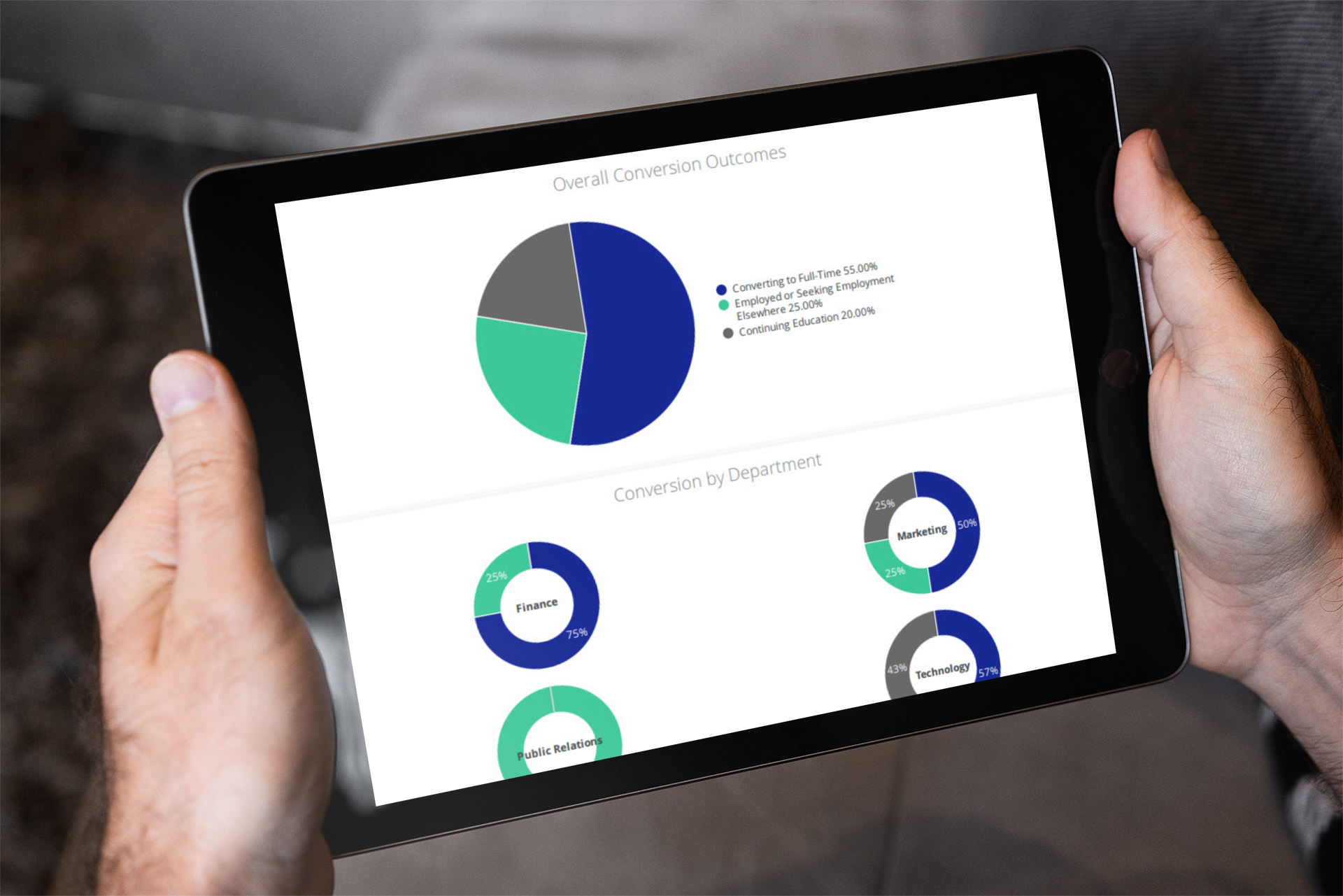
Converting your interns into full-time hires is a vital KPI to determine the ROI of your company’s internship program. In order to improve conversion rates, companies must set goals well in advance of the interns’ first day and track progress to truly know what’s effective and what’s not. You should not only measure conversion rates, but also what leads to conversions and ideally long-term employees.
GradLeaders recently conducted a survey of 43 companies with internship, coop, and LDR programs. Here are the results of the survey:
• 58% of companies have had their program in place for 10+ years
• Nearly all candidates who start their programs complete them
• 50% of those companies retain that talent for 3+ years
• 35% of companies don’t know their 3- or 5-year retention rates
• 71% of companies don’t know their 10-year retention rates
Do you know your conversion rates? How about long-term retention rates? Here are seven tips to track and improve intern-to-full-time conversion rates and retention rates at your company.
1. Develop A Strategic Plan to Develop Productive Interns
Companies should come up with a few goals and key objectives they want to accomplish with their internship program and then establish a plan to put them into full effect. What do you need your interns to accomplish? How do you define productivity for each intern? What type of previous work experience and education level is needed to be productive? This plan should be created at least a year in advance of your program’s start date. Determine how many interns you’ll need to hire, what their roles will be, and how you can optimize their time with your company to teach them the skills they need to bring them on full time.
2. Build Relationships with Students Early On
It’s important for employers to recruit during the early stages of a student’s education to build a stronger relationship. During their freshman and sophomore years, educate students about your company, typical internships and job openings, and future career path opportunities. If students learn about the requirements for a position with your company well in advance, they’ll have time to work towards those expectations and will be more likely to join your company in the future. Your company’s recruitment efforts should be an ongoing process instead of a one-time mission. Communicate with students frequently and authentically to keep them engaged and interested.
3. Recruit and Interview Students a Semester in Advance
Once your company has a plan set in place and you’ve educated students about opportunities, start interviewing qualified candidates at least a semester before the start of your program. Companies who have high conversion rates typically interview students 8 months prior to the start date. Initiate the hiring process by addressing them like employees rather than interns. This is meant to be a long-term investment so make sure candidates are aware of your goal to transition them to a full-time employee. This will motivate interns to work harder if they know there’s a potential job offer at the end of their program.
4. Stay in Touch with Interns throughout the Process
Don’t let candidates or interns ever feel disconnected – especially for virtual internships or remote co-ops. It’s important to stay in touch with candidates before their first day, during the program, and when they return to campus. Send more than “just checking in” emails too. Create value-add nurturing programs with useful resources to not only increase conversion rates but also minimize reneges on offers.
5. Give Them Real Work, Not Busy Work
In order to convert interns into full-time hires, allow them to choose the teams and projects they work on, so they’re involved in something they’re passionate about and good at At the very least, ensure their projects and tasks are meaningful and impactful if executed well. When their time is invested in purposeful work and their contributions are significant, they will be motivated to stay with your company.
6. Provide Constructive Feedback and Measure Satisfaction
Interns will typically need a lot of direction in the beginning stages of their program. Be sure to set clear expectations, stay in constant communication as they work on different projects, and provide feedback along the way to help them stay on track to reach their goals. Create an open environment where your interns feel comfortable asking questions and sharing their input. Employers should also take pulse surveys of interns a few times before, during, and after their program to track their progress and gather feedback to inform program enhancements. Consider surveying the interns’ mentors and managers as well. Ideally, you’ll not only have happy, satisfied interns, but also satisfied mentors and managers of those interns.
7. Track Everything in One Place
Lastly, do your best to track key data points on every intern in a comprehensive report or platform like our Intern Management System. During the recruitment process, record their educational background and previous work experience. Understand where you found the intern or how they found you. Keep your notes from the interview process. Record what types of projects they worked on and how well they did on those projects. And tie all of those data points to their pulse survey results. From there, it should be easy to track conversions and ultimately, retention rates for each intern then analyze what works and what doesn’t.
Follow these seven tips, and you are certain to not only have a better understanding of your conversion rates and retention rates, but also improve the ROI of your internship program.
Need help? We’d love to share what we’ve learned from our corporate partners and offer advice. Contact us today for a quick chat or demonstration of best practices.